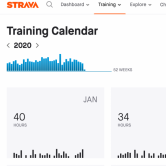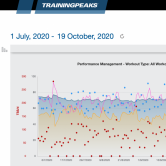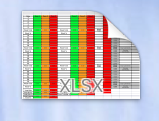
Everything is logged somewhere already
In this day and age almost everything is logged on internet-based programmes like Strava or Garmin Connect. Personally, I enjoy everything being logged, I like seeing my ride route and a few details of the ride. However, this is not a training diary. You could use it as a training diary, but it doesn’t tell you about how you felt.
You can add details into the ride descriptions that could cover the subjective details of a ride, however, when you review your recent training this becomes very difficult to read and is not very user friendly. There is a lot of clicking and waiting for pages to reload!

What about training software?
In common use for most endurance athletes is training software such as Training Peaks, Todays Plan or Golden Cheetah. These programmes go way beyond just logging rides and try to make use of the data to guide future training. With metrics developed (in Training Peaks I believe) like Acute Training Load, Chronic Training Load and Training Stress Balance you can get a good idea of your fitness and form. However, what you don’t get is how you feel about it. There have been times where the numbers looked great, but I felt totally trashed, unmotivated and unable to produce the performances on race day.
It doesn’t matter how sophisticated your algorithm in the software, it can’t tell how you feel. They introduced a nice smiley face rating for perceived session exertion and that can be used for a more subjective measure, but it’s not as user friendly as a simple diary. Especially when looking back to review recent weeks/months of training.

What works best as a training diary?
Really what works best is what helps you get the most out in the easiest way possible. Online/on the computer makes the most sense these days as they are so easy to use. Spreadsheets work the best for me. Either using Excel or Google Sheets is a great option.
Having a table set up that records your session and then a space for writing down how you felt is the key to this. If they then colour code the session as green/amber/red by colour filling the cell, the ease of use is incredible. This set-up means you can see a month on one tab and see where the rides fit together, any gaps, any intense periods and then the colour coding lets you know where to dig deeper.
If your athlete is normally (hopefully) consistently posting green rides and suddenly there are a couple of amber, red or missed sessions (hopefully addressed before you get to red/missed sessions!) you can easily see the pattern of where and when this occurred and start seeing what caused it.
Writing a few lines about how you felt about a session goes a long way, it is a great habit to get into. The most obvious benefit comes from the fact that the coach can get a read on how the sessions are going and how the athlete feels about them. Perhaps an unseen benefit from this habit is that it makes the athlete sit for a minute or two and actually think about how they feel. You will be shocked how many people unconsciously get themselves over-reaching/overtraining and only realising when it is late in the day and the recovery time is greatly extended. If you are in the habit of checking in with yourself after each session you are more consciously engaged with your training and will spot any signs of a problem in time to correct course.
Get example training Diary



